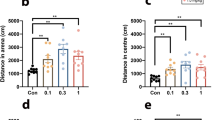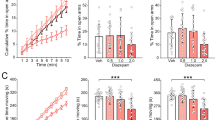Abstract
Three 5-HT agonists produced a dose-related fall in open/total arm entry ratio in the elevated X-maze model of anxiety at doses which did not affect total entries. The relative potency, 8-hydroxy-2-(di-n-propylamino)tetra lin (8-OH-DPAT)≫5-methoxy-N,N-dimethyltryptamine (5-MeODMT)>=5-methoxy-3(tetrahydropyridin-4-yl)1H-indole (RU 24969), was unrelated to the occurrence of wet dog shakes and suggests that 5-HT1 rather than 5-HT2 receptors may be involved. However, the 5-HT2 receptor antagonists ritanserin, ketanserin and seganserin caused an anxiolytic-like increase in entry ratio, although only ritanserin produced this effect across the dose range tested. +/-Pindolol, an antagonist at 5-HT1 receptors, showed a biphasic dose-response curve with a fall in entry ratio at one high dose. The effect of a submaximal dose of 8-OH-DPAT was prevented by pindolol but not by a similarly anxiolytic dose of ritanserin or diazepam. A higher dose of diazepam caused intense muscle hypotonia in combination with 8-OH-DPAT. Since open/total entry ratio appears to represent choice, rather than suppression or delay, of a response, the effects seen may indicate involvement of 5-HT receptors in anxiety separately from any change in the ability to withhold a response. The precise role of each receptor subtype, however, remains to be determined.
Similar content being viewed by others
References
Arriaga F, Leitas J, Mills FJ, Padua J, Ruiz I, Tropa J, Sousa MP (1984) R55667, an effective non-benzodiazepine anxiolytic. Proc. 14th C.I.N.P. Congr Florence [Abstr] P726
Bradley PB, Engel G, Fenuik W, Fozard JR, Humphrey PPA, Middlemiss DN, Mylecharane EJ, Richardson BP, Saxena PR (1986) Proposals for the classification and nomenclature of functional receptors for 5-HT. Neuropharmacology 25:563–576
Ceulemans D, Hoppenbrouwers ML, Gelders Y, Reyntjens A (1984) Serotonin blockade or benzodiazepines: What kind of anxiolysis? Proc 14th C.I.N.P. Congr Florence [Abstr] P726
Colpaert FC, Meet TF, Niemegeers CJE, Janssen PAJ (1985) Behavioural and 5-HT antagonist effects of ritanserin: a pure and selective antagonist of LSD discrimination in the rat. Psychopharmacology 86:45–54
Dourish CT, Hutson PH, Curzon G (1985) Low doses of the putative serotonin agonist 8-hydroxy-2(di-n-propylamino)tetralin (8-OH-DPAT) elicit feeding in the rat. Psychopharmacology 86:197–204
Engel JA, Hjorth S, Svensson K, Carlsson A, Liljequist B (1984) Anticonflict effects of the putative serotonin receptor agonist 8-hydroxy-2-(di-n-propylamino)tetralin (8-OH-DPAT). Eur J Pharmacol 105:365–368
File SE, Johnston AL, Pellow S (1987) Effects of compounds acting at CNS 5-hydroxytryptamine systems on anxiety in the rat. Br J Pharmacol 90:265P
Gardner CR (1985) Pharmacological studies of the role of serotonin in animal models of anxiety. In: Green AR (ed) Neuropharmacology of serotonin. Oxford University Press, New York
Gardner CR (1986) Recent developments in 5-HT-related pharmacology of animal models of anxiety. Pharmacol Biochem Behav 24:1479–1485
Handley SL, Mithani S (1984) Effects of α-adrenoceptor agonists and antagonists in a maze-exploration model of ‘fear-motivated’ behaviour. Naunyn-Schmiedeberg's Arch Pharmacol 327:1–5
Hjorth S, Carlsson A (1986) Is pindolol a mixed agonist-antagonist at central serotonin (5-HT) receptors? Eur J Pharmacol 129:131–138
Hutson PH, Dourish CT, Curzon G (1986) Neurochemical and behavioural evidence for mediation of the hyperphagic action of 8-OH-DPAT by 5-HT cell body autoreceptors. Eur J Pharmacol 129:347–352
Janssen PAJ (1985) The pharmacology of potent and selective S2-serotonergic antagonists. J Cardiovasc Pharmacol [Suppl 7] 7:S2-S11
Johnston AL, File SE (1986) 5-HT and anxiety: promises and pitfalls. Pharmacol Biochem Behav 24:1467–1470
Leysen JE, Awouters F, Kennis L, Laduron PM, Vaneberk PAJ (1981) Receptor profile of R41468 (ketanserin) a novel antagonist at 5-HT2 receptors. Life Sci 28:1015–1022
Leysen JE, Gommeren W, Van Gompel P, Wynants J, Janssen PFM, Laduron PM (1985) Receptor binding properties in vitro and in vivo of ritanserin: a very potent and long acting serotonin-S2 antagonist. Mol Pharmacol 27:600–611
Middlemiss DN, Blakeborough L, Leather SR (1977) Direct evidence for an interaction of β-adrenergic blockers with the 5-HT receptor. Nature 267:289
Montgomery KC (1955) The relation between fear induced by novel stimulation and exploratory behaviour. J Comp Physiol Psychol 48:254–260
Nahorski SR, Wilcocks AL (1983) Interactions of β-adrenoceptor antagonists with 5-hydroxytryptamine receptor subtypes in rat cerebral cortex. Br J Pharmacol 78:107P
Pedigo NW, Yamamura HI, Nelson DL (1981) Discrimination of multiple [3H]-5-Hydroxytryptamine binding sites by the neuroleptic spiperone in the rat brain. J Neurochem 36:220
Pellow S, File SE (1986) Anxiolytic and anxiogenic drug effects on exploratory activity in an elevated plus-maze. A novel test of anxiety in the rat. Pharmacol Biochem Behav 24:525–529
Pellow S, Chopin P, File SE, Briley M (1985) Validation of open: closed arm entries in an elevated plus-maze as a measure of anxiety in the rat. J Neurosci Methods 14:149–167
Peroutka SJ, Snyder SH (1979) Multiple serotonin receptors: Differential binding of [3H]-5-HT, [3H]-LSD and [3H]-spiroperidol. Mol Pharmacol 16:687–699
Richardson BP, Engel G (1986) The pharmacology and function of 5-HT3 receptors. Trends Neurol Sci 9:424
Shephard RA, Buxton DA, Broadhurst PL (1982) Drug interactions do not support reduction of serotonin turnover as a mechanism of action of benzodiazepines. Neuropharmacology 21:1027
Soubrié P (1986) Neurones sérotoninergiques et comportement. J Pharmacol 17:107–112
Thiébot MH (1986) Are serotonergic neurones involved in the control of anxiety and in the anxiolytic activity of benzodiazepines? Pharmacol Biochem Behav 24:1471–1477
Tricklebank MD (1985) The behavioural response to 5-HT receptor agonists and subtypes of the central 5-HT receptor. TIPS 6:403–407
Tricklebank MD, Forler C, Fozard JR (1985) The involvement of subtypes of the 5-HT1 receptor and of catecholaminergic systems in the behavioural response to 8-hydroxy-2-(di-n-propylamino)tetralin in the rat. Eur J Pharmacol 106:271–282
Tricklebank MD, Middlemiss DN, Neill J (1986) Pharmacological analysis of the behavioural and thermoregulatory effects of the putative 5-HT1 receptor agonist, RU 24969 in the rat. Neuropharmacology 25:877–886
Author information
Authors and Affiliations
Rights and permissions
About this article
Cite this article
Critchley, M.A.E., Handley, S.L. Effects in the X-maze anxiety model of agents acting at 5-HT1 and 5-HT2 receptors. Psychopharmacology 93, 502–506 (1987). https://doi.org/10.1007/BF00207243
Received:
Revised:
Issue Date:
DOI: https://doi.org/10.1007/BF00207243




